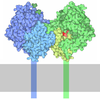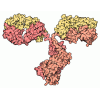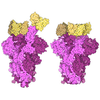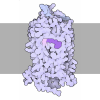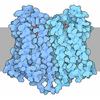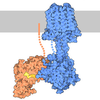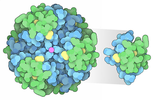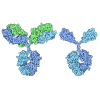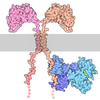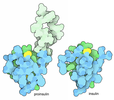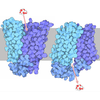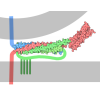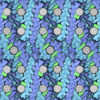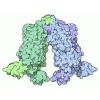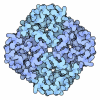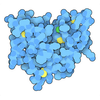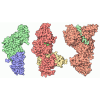+ Open data
Open data
- Basic information
Basic information
| Entry | Database: PDB / ID: 9ejc | |||||||||||||||
|---|---|---|---|---|---|---|---|---|---|---|---|---|---|---|---|---|
| Title | Cryo-EM Structure of CXCL1-KSHV ORF74-Gi-scFv16 Complex | |||||||||||||||
 Components Components |
| |||||||||||||||
 Keywords Keywords | VIRAL PROTEIN/SIGNALING PROTEIN / KSHV vGPCR / Viral GPCR / KSHV ORF74 / ORF74-CXCL1 / ORF74 Active / CXCL1 bound ORF74 / KSHV ORF74-CXCL1-Gi-scFv16 / VIRAL PROTEIN / VIRAL PROTEIN-SIGNALING PROTEIN complex | |||||||||||||||
| Function / homology |  Function and homology information Function and homology informationC-C chemokine receptor activity / C-C chemokine binding / chemokine activity / Chemokine receptors bind chemokines / Interleukin-10 signaling / adenylate cyclase inhibitor activity / positive regulation of protein localization to cell cortex / Adenylate cyclase inhibitory pathway / T cell migration / D2 dopamine receptor binding ...C-C chemokine receptor activity / C-C chemokine binding / chemokine activity / Chemokine receptors bind chemokines / Interleukin-10 signaling / adenylate cyclase inhibitor activity / positive regulation of protein localization to cell cortex / Adenylate cyclase inhibitory pathway / T cell migration / D2 dopamine receptor binding / response to prostaglandin E / adenylate cyclase regulator activity / G protein-coupled serotonin receptor binding / adenylate cyclase-inhibiting serotonin receptor signaling pathway / cellular response to forskolin / regulation of mitotic spindle organization / cell chemotaxis / Regulation of insulin secretion / growth factor activity / enzyme activator activity / positive regulation of cholesterol biosynthetic process / calcium-mediated signaling / negative regulation of insulin secretion / G protein-coupled receptor binding / response to peptide hormone / adenylate cyclase-inhibiting G protein-coupled receptor signaling pathway / adenylate cyclase-modulating G protein-coupled receptor signaling pathway / G-protein beta/gamma-subunit complex binding / centriolar satellite / Olfactory Signaling Pathway / Activation of the phototransduction cascade / specific granule lumen / G beta:gamma signalling through PLC beta / Presynaptic function of Kainate receptors / Thromboxane signalling through TP receptor / G protein-coupled acetylcholine receptor signaling pathway / G-protein activation / Activation of G protein gated Potassium channels / Inhibition of voltage gated Ca2+ channels via Gbeta/gamma subunits / Prostacyclin signalling through prostacyclin receptor / G beta:gamma signalling through CDC42 / chemotaxis / Glucagon signaling in metabolic regulation / G beta:gamma signalling through BTK / Synthesis, secretion, and inactivation of Glucagon-like Peptide-1 (GLP-1) / ADP signalling through P2Y purinoceptor 12 / photoreceptor disc membrane / Sensory perception of sweet, bitter, and umami (glutamate) taste / Glucagon-type ligand receptors / Adrenaline,noradrenaline inhibits insulin secretion / Vasopressin regulates renal water homeostasis via Aquaporins / GDP binding / Glucagon-like Peptide-1 (GLP1) regulates insulin secretion / G alpha (z) signalling events / cellular response to catecholamine stimulus / ADP signalling through P2Y purinoceptor 1 / ADORA2B mediated anti-inflammatory cytokines production / G beta:gamma signalling through PI3Kgamma / Cooperation of PDCL (PhLP1) and TRiC/CCT in G-protein beta folding / adenylate cyclase-activating dopamine receptor signaling pathway / tertiary granule lumen / GPER1 signaling / Inactivation, recovery and regulation of the phototransduction cascade / cellular response to prostaglandin E stimulus / G-protein beta-subunit binding / heterotrimeric G-protein complex / nervous system development / G alpha (12/13) signalling events / sensory perception of taste / extracellular vesicle / signaling receptor complex adaptor activity / Thrombin signalling through proteinase activated receptors (PARs) / retina development in camera-type eye / G protein activity / positive regulation of cytosolic calcium ion concentration / GTPase binding / Ca2+ pathway / actin cytoskeleton organization / fibroblast proliferation / midbody / High laminar flow shear stress activates signaling by PIEZO1 and PECAM1:CDH5:KDR in endothelial cells / cell cortex / G alpha (i) signalling events / G alpha (s) signalling events / phospholipase C-activating G protein-coupled receptor signaling pathway / G alpha (q) signalling events / Hydrolases; Acting on acid anhydrides; Acting on GTP to facilitate cellular and subcellular movement / Ras protein signal transduction / Extra-nuclear estrogen signaling / cell population proliferation / intracellular signal transduction / immune response / ciliary basal body / G protein-coupled receptor signaling pathway / inflammatory response / signaling receptor binding / negative regulation of cell population proliferation / lysosomal membrane / cell division / GTPase activity Similarity search - Function | |||||||||||||||
| Biological species |  Homo sapiens (human) Homo sapiens (human) 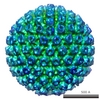 Human gammaherpesvirus 8 Human gammaherpesvirus 8 | |||||||||||||||
| Method | ELECTRON MICROSCOPY / single particle reconstruction / cryo EM / Resolution: 2.98 Å | |||||||||||||||
 Authors Authors | Sahoo, B. / Seo, H.D. / Dai, X. / Jung, J. | |||||||||||||||
| Funding support |  United States, 1items United States, 1items
| |||||||||||||||
 Citation Citation |  Journal: Nat Commun / Year: 2025 Journal: Nat Commun / Year: 2025Title: Structural basis for ligand promiscuity and high signaling activity of Kaposi's Sarcoma-associated Herpesvirus-encoded GPCR. Authors: Jun Bae Park / Bibekananda Sahoo / Amita Rani Sahoo / Dokyun Kim / Hogyu David Seo / James Bowman / Mi-Jeong Kwak / Sophia Suh / Matthias Buck / Xinghong Dai / Jae U Jung /  Abstract: Kaposi's Sarcoma-associated Herpesvirus encodes ORF74, a viral G protein-coupled receptor homologous to CXCR2, which plays a crucial role in Kaposi's Sarcoma development through its high basal ...Kaposi's Sarcoma-associated Herpesvirus encodes ORF74, a viral G protein-coupled receptor homologous to CXCR2, which plays a crucial role in Kaposi's Sarcoma development through its high basal signaling activity. Our cryoEM analysis of ORF74 in ligand-free, BRIL-fused ligand-free, and CXCL1/Gi-bound forms elucidates its ligand-independent signaling activity. A widely open, static extracellular cavity facilitates ligand promiscuity by enabling dynamic access and diverse binding modes. Structural alterations in CWxP, E/DRY, and NPxxY micro-switches stabilize the active conformation, leading to constitutive signaling. Metadynamics simulations reveal a dynamic ensemble between local switch structures corresponding to the inactive and active states, supporting spontaneous activation. CXCR2-ORF74 chimeras highlight intracellular loops 2 and 3 as key modulators of basal and agonist-induced activity. This study defines the structural basis of ORF74's ligand promiscuity, spontaneous activation, and high basal signaling, providing insights into its role in viral oncogenesis. | |||||||||||||||
| History |
|
- Structure visualization
Structure visualization
| Structure viewer | Molecule:  Molmil Molmil Jmol/JSmol Jmol/JSmol |
|---|
- Downloads & links
Downloads & links
- Download
Download
| PDBx/mmCIF format |  9ejc.cif.gz 9ejc.cif.gz | 254 KB | Display |  PDBx/mmCIF format PDBx/mmCIF format |
|---|---|---|---|---|
| PDB format |  pdb9ejc.ent.gz pdb9ejc.ent.gz | 195.5 KB | Display |  PDB format PDB format |
| PDBx/mmJSON format |  9ejc.json.gz 9ejc.json.gz | Tree view |  PDBx/mmJSON format PDBx/mmJSON format | |
| Others |  Other downloads Other downloads |
-Validation report
| Summary document |  9ejc_validation.pdf.gz 9ejc_validation.pdf.gz | 821 KB | Display |  wwPDB validaton report wwPDB validaton report |
|---|---|---|---|---|
| Full document |  9ejc_full_validation.pdf.gz 9ejc_full_validation.pdf.gz | 825.8 KB | Display | |
| Data in XML |  9ejc_validation.xml.gz 9ejc_validation.xml.gz | 35.6 KB | Display | |
| Data in CIF |  9ejc_validation.cif.gz 9ejc_validation.cif.gz | 55.4 KB | Display | |
| Arichive directory |  https://data.pdbj.org/pub/pdb/validation_reports/ej/9ejc https://data.pdbj.org/pub/pdb/validation_reports/ej/9ejc ftp://data.pdbj.org/pub/pdb/validation_reports/ej/9ejc ftp://data.pdbj.org/pub/pdb/validation_reports/ej/9ejc | HTTPS FTP |
-Related structure data
| Related structure data |  48100MC  8w1aC C: citing same article ( M: map data used to model this data |
|---|---|
| Similar structure data | Similarity search - Function & homology  F&H Search F&H Search |
- Links
Links
- Assembly
Assembly
| Deposited unit | 
|
|---|---|
| 1 |
|
- Components
Components
-Guanine nucleotide-binding protein ... , 3 types, 3 molecules BCA
| #1: Protein | Mass: 39660.293 Da / Num. of mol.: 1 Source method: isolated from a genetically manipulated source Source: (gene. exp.)  Homo sapiens (human) / Gene: GNB1 / Production host: Homo sapiens (human) / Gene: GNB1 / Production host:  Trichoplusia ni (cabbage looper) / References: UniProt: P62873 Trichoplusia ni (cabbage looper) / References: UniProt: P62873 |
|---|---|
| #2: Protein | Mass: 7861.143 Da / Num. of mol.: 1 Source method: isolated from a genetically manipulated source Source: (gene. exp.)  Homo sapiens (human) / Gene: GNG2 / Production host: Homo sapiens (human) / Gene: GNG2 / Production host:  Trichoplusia ni (cabbage looper) / References: UniProt: P59768 Trichoplusia ni (cabbage looper) / References: UniProt: P59768 |
| #5: Protein | Mass: 40415.031 Da / Num. of mol.: 1 Source method: isolated from a genetically manipulated source Source: (gene. exp.)  Homo sapiens (human) / Gene: GNAI1 / Production host: Homo sapiens (human) / Gene: GNAI1 / Production host:  Trichoplusia ni (cabbage looper) Trichoplusia ni (cabbage looper)References: UniProt: P63096, Hydrolases; Acting on acid anhydrides; Acting on GTP to facilitate cellular and subcellular movement |
-Protein , 2 types, 2 molecules EF
| #3: Protein | Mass: 39601.523 Da / Num. of mol.: 1 / Mutation: G30C, L169W, L258V Source method: isolated from a genetically manipulated source Source: (gene. exp.)   Human gammaherpesvirus 8 / Gene: ORF74 / Production host: Human gammaherpesvirus 8 / Gene: ORF74 / Production host:  |
|---|---|
| #4: Protein | Mass: 10131.754 Da / Num. of mol.: 1 / Mutation: N22C Source method: isolated from a genetically manipulated source Source: (gene. exp.)  Homo sapiens (human) / Gene: CXCL1, GRO, GRO1, GROA, MGSA, SCYB1 / Production host: Homo sapiens (human) / Gene: CXCL1, GRO, GRO1, GROA, MGSA, SCYB1 / Production host:  |
-Antibody , 1 types, 1 molecules D
| #6: Antibody | Mass: 30895.527 Da / Num. of mol.: 1 Source method: isolated from a genetically manipulated source Source: (gene. exp.)   |
|---|
-Details
| Has protein modification | Y |
|---|
-Experimental details
-Experiment
| Experiment | Method: ELECTRON MICROSCOPY |
|---|---|
| EM experiment | Aggregation state: PARTICLE / 3D reconstruction method: single particle reconstruction |
- Sample preparation
Sample preparation
| Component |
| ||||||||||||||||||||||||||||||||||||
|---|---|---|---|---|---|---|---|---|---|---|---|---|---|---|---|---|---|---|---|---|---|---|---|---|---|---|---|---|---|---|---|---|---|---|---|---|---|
| Molecular weight | Value: 0.14 MDa / Experimental value: NO | ||||||||||||||||||||||||||||||||||||
| Source (natural) |
| ||||||||||||||||||||||||||||||||||||
| Source (recombinant) |
| ||||||||||||||||||||||||||||||||||||
| Buffer solution | pH: 7.5 Details: 10 mM HEPES pH 7.5, 150 mM NaCl, 0.001% (w/v) LMNG, 0.0001% (w/v) CHS, 0.001% (w/v) GDN | ||||||||||||||||||||||||||||||||||||
| Buffer component | Conc.: 10 mM / Name: HPEPS / Formula: C8H18N2O4S | ||||||||||||||||||||||||||||||||||||
| Specimen | Conc.: 10 mg/ml / Embedding applied: NO / Shadowing applied: NO / Staining applied: NO / Vitrification applied: YES | ||||||||||||||||||||||||||||||||||||
| Vitrification | Instrument: FEI VITROBOT MARK IV / Cryogen name: ETHANE / Humidity: 100 % / Chamber temperature: 278 K |
- Electron microscopy imaging
Electron microscopy imaging
| Experimental equipment |  Model: Titan Krios / Image courtesy: FEI Company |
|---|---|
| Microscopy | Model: TFS KRIOS |
| Electron gun | Electron source:  FIELD EMISSION GUN / Accelerating voltage: 300 kV / Illumination mode: FLOOD BEAM FIELD EMISSION GUN / Accelerating voltage: 300 kV / Illumination mode: FLOOD BEAM |
| Electron lens | Mode: BRIGHT FIELD / Nominal defocus max: 1500 nm / Nominal defocus min: 800 nm |
| Image recording | Electron dose: 50 e/Å2 / Film or detector model: GATAN K3 BIOQUANTUM (6k x 4k) |
- Processing
Processing
| EM software | Name: PHENIX / Category: model refinement | ||||||||||||||||||||||||
|---|---|---|---|---|---|---|---|---|---|---|---|---|---|---|---|---|---|---|---|---|---|---|---|---|---|
| CTF correction | Type: PHASE FLIPPING AND AMPLITUDE CORRECTION | ||||||||||||||||||||||||
| 3D reconstruction | Resolution: 2.98 Å / Resolution method: FSC 0.143 CUT-OFF / Num. of particles: 190755 / Symmetry type: POINT | ||||||||||||||||||||||||
| Refinement | Highest resolution: 2.98 Å Stereochemistry target values: REAL-SPACE (WEIGHTED MAP SUM AT ATOM CENTERS) | ||||||||||||||||||||||||
| Refine LS restraints |
|
 Movie
Movie Controller
Controller








 PDBj
PDBj